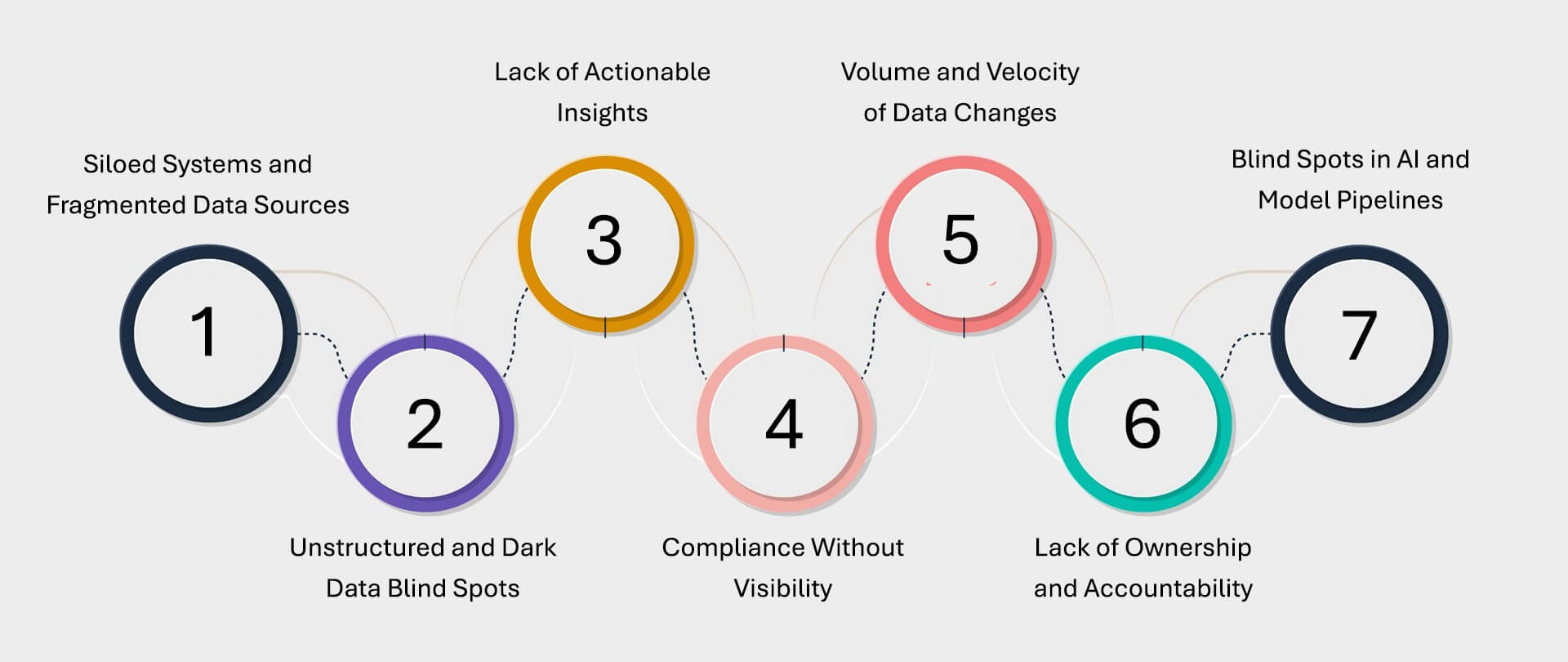What is Data Observability?
Data Observability is the ability to monitor, understand, and assess the health, quality, and performance of data as it flows through an organization’s systems and pipelines. It involves tracking key metrics and signals, such as data freshness, accuracy, completeness, and consistency, to detect and resolve issues in real-time. By providing visibility into how data is being processed, stored, and used, data observability helps ensure that data remains reliable, trustworthy, and fit for purpose, enabling better decision-making and more effective data management.
At its core, data observability empowers enterprises to answer critical questions in real time:
- Is my data complete and accurate?
- Where did it originate?
- Who accessed it and why?
- Is it behaving as expected across systems?
By providing this level of visibility, observability lays the groundwork for trustworthy AI, proactive governance, and intelligent data operations.
Why Data Observability Matters in 2025
In 2025, enterprises are expected to process more than 180 zettabytes of data globally, with over 80% of it unstructured. This explosion of data, coupled with AI adoption, regulatory scrutiny, and hybrid environments, has exposed a glaring blind spot: most organizations don’t know what’s happening inside their data estates.
That’s where data observability becomes a strategic asset.
It enables organizations to:
- Detect anomalies and data quality issues before they corrupt downstream analytics or AI models.
- Identify usage patterns and access risks, improving security posture.
- Support compliance mandates by providing end-to-end lineage and audit trails.
- Optimize data storage, access, and cost by understanding how data is being used (or not used).
With observability, enterprises shift from reactive firefighting to real-time, data-driven decision-making.
Challenges in Achieving Data Observability — And What to Do

Siloed Systems and Fragmented Data Sources
Data is scattered across on-prem, multi-cloud, SaaS platforms, and edge environments—each with unique architectures and limited integration.
What to do:
Deploy unified observability platforms that support API-based integrations and real-time ingestion from heterogeneous sources. Look for solutions that offer federated visibility without requiring centralization.
Unstructured and Dark Data Blind Spots
Up to 80% of enterprise data is unstructured—files, emails, videos, chats—and often remains invisible to monitoring tools.
What to do:
Use AI/ML-based discovery engines to identify, classify, and contextualize unstructured and dark data. Combine metadata analytics with content scanning to enable observability at scale.
Lack of Actionable Insights
Monitoring dashboards often flood teams with noise rather than clarity, offering metrics but no context or resolution paths.
What to do:
Adopt tools that provide automated root cause analysis, anomaly detection, and contextual recommendations. Look for capabilities like natural language summaries and correlation graphs.
Compliance Without Visibility
Global regulations demand transparency, yet most enterprises can’t trace who accessed what data, when, and why.
What to do:
Integrate observability with access governance, lineage tracking, and audit reporting. Ensure that systems can generate real-time compliance logs aligned with GDPR, DPDP, HIPAA, and CCPA.
Volume and Velocity of Data Changes
As enterprises generate terabytes daily, it’s impossible to manually track changes in quality, schema, or lineage.
What to do:
Automate change detection and quality checks using event-driven observability workflows and real-time alerts for schema drift, broken pipelines, or data degradation.
Lack of Ownership and Accountability
Without clearly defined data owners or stewards, observability insights often fall into a void, unresolved and unacted upon.
What to do:
Map observability metrics to data stewardship roles and business units, ensuring responsibility and follow-through. Use role-based access controls (RBAC) to personalize observability views and actions.
Blind Spots in AI and Model Pipelines
AI models are fed data with little to no visibility into its freshness, origin, or bias.
What to do:
Embed observability directly into model training and inference pipelines, tracking the quality, completeness, and ethics of datasets used, enabling trustworthy, explainable AI.
Seeing the Invisible: Why Data Observability Is the New Enterprise Superpower
In a world where data flows constantly across apps, clouds, edge devices, and AI pipelines, enterprises are often flying blind. Data observability changes that. It’s not just a back-end technical function—it’s the strategic control panel for a resilient, intelligent, and compliant digital enterprise.
As artificial intelligence systems demand clean, explainable, and unbiased data, observability ensures visibility into every stage of the pipeline—from ingestion to inference. It helps identify if a dataset is complete, if it’s drifting, or if it’s introducing risk. Without it, AI becomes a black box. With it, AI becomes trustworthy.
On the compliance front, data observability enables real-time accountability. Enterprises no longer need to scramble during audits or regulatory reviews. With lineage tracking, access visibility, and intelligent alerts, governance becomes proactive, enforcing rules before breaches occur or data misuse spirals out of control.
But its most powerful impact is in operational trust. As data becomes the foundation of every business process—supply chains, customer experiences, risk models—observability ensures that decision-makers aren’t relying on assumptions, but on verifiable, real-time truth.
Forward-looking organizations are embedding observability into their digital core—not as an IT add-on, but as a strategic multiplier that powers everything from responsible AI to business agility.
Because in the data age, what you can’t see can cost you. And what you can observe, you can trust, optimize, and scale.
Data observability bridges the gap between raw data and real value. It offers enterprises the visibility, transparency, and control needed to power responsible AI, meet regulatory expectations, and future-proof digital operations. In the coming years, observability will define the difference between data-driven and data-blind enterprises.
Getting Started with Data Dynamics:
- Learn about Unstructured Data Management
- Schedule a demo with our team
- Read the latest blog: Sovereign AI and the Future of Nations: Why Data, Infrastructure, and Intelligence Must Align






